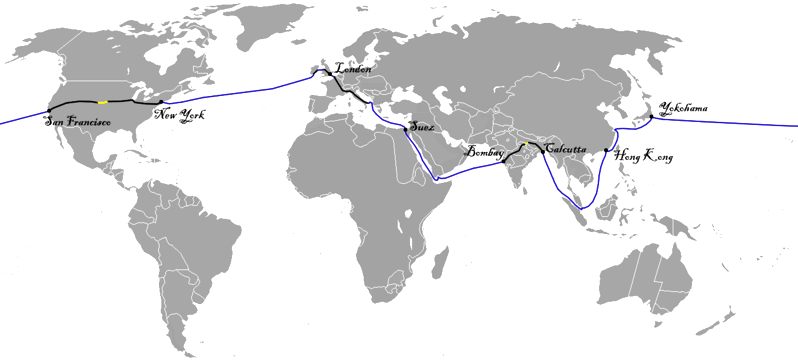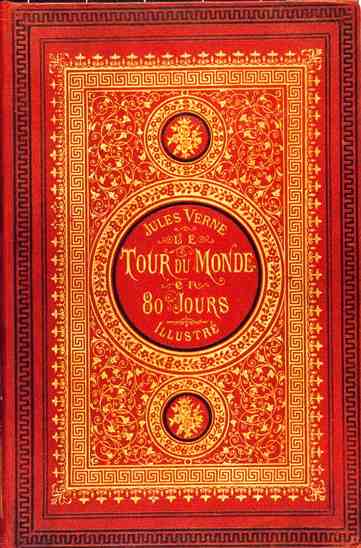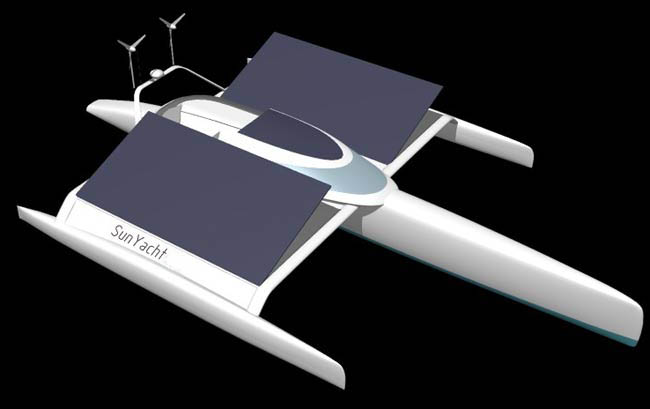|
||||||||||||||||||||||||||||||||||||||||||||||||||||||||||||||||||||||||||||||||||||||||||||||||||||||||||||||||||||||||||||||||||||||||||||||||||||||||||||||||||||||||||||
|
AROUND THE WORLD IN 80 DAYS ON WATER (WORLD HYDROGEN CHALLENGE)
In 1874 Jules Verne predicted that an energy source derived from water would exceed coal. This was in his book: The Mysterious Island. The 150th anniversary of such prediction is 2024. The table below illustrates a route that would enable a LH2 powered vessel to navigate Around the World in 80 Days.
Around the World in Eighty Days (French: Le tour du monde en quatre-vingts jours) is a classic adventure novel by the French writer Jules Verne, first published in 1873. In the story, Phileas Fogg of London and his newly-employed French valet Passepartout attempt to circumnavigate the world in 80 days on a £20,000 wager set by his friends at the Reform Club.
Map of the 80 day World trip by Phileas Fogg
Background and analysis
Around the World in Eighty Days was written during difficult times both for France and for Verne. It was during the Franco-Prussian War (1870-1871) in which Verne was conscripted as a coastguard, he was having money difficulties (his previous works were not paid royalties), recently his father had died, and he had witnessed a public execution which had disturbed him. However despite all this Verne was excited about his work on the new book, the idea of which came to him one afternoon in a Paris café while reading a newspaper (see "Origins" below).
The technological innovations of the 19th century had opened the possibility of rapid circumnavigation and the prospect fascinated Verne and his readership. In particular three technological breakthroughs occurred in 1869-70 that made a tourist-like around the world journey possible for the first time: the completion of the First Transcontinental Railroad in America (1869), the linking of the Indian railways across the sub-continent (1870), and the opening of the Suez Canal (1869). It was another notable mark in the end of an age of exploration and the start of an age of fully global tourism which could be enjoyed in relative comfort and safety. It sparked the imagination that anyone could sit down, draw up a schedule, buy tickets and travel around the world, a feat previously reserved for only the most heroic and hardy of adventurers. It is comparable in some respects today to civilian space tourism, a realm normally reserved for an elite professional few.
Verne is often characterized as a futurist or science fiction author, but there is not a glimmer of science-fiction in this, his most popular work (at least in English speaking countries.) Rather than any futurism, it remains a memorable portrait of the British Empire "on which the sun never sets" at its very peak, drawn by an outsider. It is also interesting to note that, as of 2006, there has never been a critical edition of Around the World in Eighty Days. This is in part due to the poor translations available of his works, the stereotype of "science fiction" or "boys' literature". However Verne's works were being looked at more seriously in the late 20th and early 21st centuries, with new translations and scholarship appearing.
The closing date of the novel, 22 December, 1872, was also the same date as the serial publication. As it was being published serially for the first time, some readers believed that the journey was actually taking place — bets were placed, and some railway companies and ship liner companies actually lobbied Verne to appear in the book! It is unknown if Verne actually submitted to their requests, but the descriptions of some rail and shipping lines leave some suspicion he was influenced.
Although a journey by hot air balloon has become one of the images most strongly associated with the story, this iconic symbol was never deployed in the book by Verne himself - the idea is briefly brought up in chapter 32, but dismissed, it "would have been highly risky and, in any case, impossible." However the popular 1956 movie adaptation Around the World in Eighty Days floated the balloon idea, and it has now become a part of the mythology of the story, even appearing on book covers. This plot element is reminiscent of Verne's earlier Five Weeks in a Balloon which first made him a well-known author.
Following Towle and d'Anver's 1873 English translation, there have been hundreds of publicity-seekers who have emulated Fogg's fictional circumnavigation, often within self-imposed constraints:
Origins
The idea of a trip around the world within a set time frame had clear external origins and was popular before Verne published his book in 1872. Even the title Around the World in Eighty Days is not original to Verne. About six sources have been suggested as the origins of the story:
Greek traveler Pausanias (c. 100 AD) wrote a work that was translated into French in 1797 as Voyage autour du monde ("Around the World"). Verne's friend, Jacques Arago, had written a very popular Voyage autour du monde in 1853. However in 1869-70 the idea of traveling around the world reached critical popular attention when three technological breakthroughs occurred: the completion of the First Transcontinental Railroad in America (1869), the linking of the Indian railways across the sub-continent (1870), and the opening of the Suez Canal (1869). In 1871 appeared Around the World by Steam, via Pacific Railway, published by the Union Pacific Railroad Company, and an Around the World in A Hundred and Twenty Days by Edmond Planchut. Between 1869 and 1871, an American William Perry Fogg went around the world describing his tour in a series of letters to the Cleveland Leader, titled Round the World: Letters from Japan, China, India, and Egypt (1872).
In 1872 Thomas Cook organized the first around the world tourist trip, leaving on 20 September, 1872 and returning seven months later. The journey was described in a series of letters that were later published in 1873 as Letter from the Sea and from Foreign Lands, Descriptive of a tour Round the World. Scholars have pointed out similarities between Verne's account and Cook's letters, although some argue that Cook's trip happened too late to influence Verne. Verne, according to a second-hand 1898 account, refers to a Thomas Cook advertisement as a source for the idea of his book. In interviews in 1894 and 1904 Verne himself says the source was "through reading one day in a Paris cafe" and "due merely to a tourist advertisement seen by chance in the columns of a newspaper." Around the World itself says the origins was a newspaper article. All of these point to Cook's advert as being a probable spark for the idea of the book.
Further, the periodical Le Tour du monde (3 October, 1869) contained a short piece entitled "Around the World in Eighty Days", which refers to "140 miles" of railway not yet completed between Alahabad and Bombay, a central point in Verne's work. But even the Le Tour de monde article was not entirely original, it cites in its bibliography the Nouvelles Annales des Voyages, de la Géographie, de l'Histoire et de l'Archéologie (August, 1869), which also contains the title Around the World in Eighty Days in its contents page. The Nouvelles Annales were written by Conrad Malte-Brun (1775-1826) and his son Victor Adolphe Malte-Brun (1816-1889). Scholars believe Verne was aware of either the Le Tour de monde article, or the Nouvelles Annales (or both), and consulted it - the 'Le Tour du monde even included a trip schedule very similar to Verne's final version.
Another possible source is the traveler George Francis Train who made four trips around the world, including one in 80-days in 1870. Similarities include the hiring of a private train and his being imprisoned. Train later claimed "Verne stole my thunder. I'm Phileas Fogg."
Regarding the idea of gaining a day, Verne said of its origin: "I have a great number of scientific odds and ends in my head. It was thus that, when, one day in a Paris café, I read in the Siècle that a man could travel around the world in eighty days, it immediately struck me that I could profit by a difference of meridian and make my traveller gain or lose a day in his journey. There was a dènouement [sic] ready found. The story was not written until long after. I carry ideas about in my head for years - ten, or fifteen years, sometimes - before giving them form." In his lecture of April 1873 "The Meridians and the Calendar", Verne responded to a question about where the change of day actually occurred, since the international date line had only become current in 1880 and the Greenwich prime meridian was not adopted internationally until 1884. Verne cited an 1872 article in Nature, and Edgar Allan Poe's short story "Three Sundays in a Week" (1841), which was also based on going around the world and the difference in a day linked to a marriage at the end. Verne even analyzed Poe's story in his Edgar Poe and His Works (1864).
In summary either the periodical 'Le Tour du monde or the Nouvelles Annales, W. P. Fogg, probably Thomas Cook's advert (and maybe his letters) would be the main likely source for the book. In addition Poe's short story "Three Sundays in a Week" was clearly the inspiration for the lost day plot device.
Plot summary
The story starts in London on October 2, 1872. Phileas Fogg is a wealthy, solitary, unmarried gentleman with regular habits. The source of his wealth is not known and he lives modestly. He fires his former valet, James Forster, for bringing him shaving water two degrees too cold. He hires as a replacement Passepartout, a Frenchman of around 30 years of age.
Later that day in the Reform Club, he gets involved in an argument over an article in The Daily Telegraph, stating that with the opening of a new railway section in India, it is now possible to travel around the world in 80 days.
The proposed schedule
Fogg accepts a wager for £20,000 from his fellow club members, which he will receive if he makes it around the world in 80 days. Accompanied by his manservant Passepartout, he leaves London by train at 8.45 p.m. on October 2, 1872, and thus is due back at the Reform Club at the same time 80 days later, on December 21.
Fogg and Passepartout reach Suez in time. While disembarking in Egypt, he is watched by a Scotland Yard detective named Fix, who has been dispatched from London in search of a bank robber. Because Fogg matches the description of the bank robber, Fix mistakes Fogg to be the criminal. Since he cannot secure a warrant in time, Fix goes on board of the steamer conveying the travelers to Bombay. During the voyage, Fix gets acquainted with Passepartout, without revealing his purpose.
Still on time, Fogg and Passepartout switch to the railway in Bombay, setting off for Calcutta, Fix now following them undercover. As it turns out, the construction of the railway is not totally finished, so they are forced to get over the remaining gap between two stations by riding an elephant, which Phileas Fogg purchases at the prodigious price of 2,000 pounds.
During the ride, they come across a suttee procession, in which a young Parsi woman, Aouda, is led to a sanctuary to be sacrificed the next day. Since the young woman is drugged with the smoke of opium and hemp and obviously not going voluntarily, the travelers decide to rescue her. They follow the procession to the site, where Passepartout secretly takes the place of Aouda's deceased husband on the funeral pyre, on which she is to be burned the next morning. During the ceremony, he then rises from the pyre, scaring off the priests, and carries the young woman away.
The travelers then hasten on to catch the train at the next railway station, taking Aouda with them. At Calcutta, they finally board a steamer going to Hong Kong. Fix, who had secretly been following them, has Fogg and Passepartout arrested in Calcutta. But they jump bail and Fix is forced to follow them to Hong Kong. On board, he shows himself to Passepartout, who is delighted to meet again his traveling companion from the earlier voyage.
In Hong Kong, it turns out that Aouda's distant relative in whose care they had been planning to leave her there, has moved, likely to Holland, so they decide to take her with them to Europe. Meanwhile, still without a warrant, Fix sees Hong Kong as his last chance to arrest Fogg on British soil. He therefore confides in Passepartout, who does not believe a word and remains convinced that his master is not a bank robber. To prevent Passepartout from informing his master about the premature departure of their next vessel, Fix gets Passepartout drunk and drugs him in an opium den. In his dizziness, Passepartout yet manages to catch the steamer to Yokohama, but neglects to inform Fogg.
Fogg, on the next day, discovers that he has missed his connection. He goes in search of a vessel which will take him to Yokohama. He finds a pilot boat which takes him and his companions (Aouda and Fix) to Shanghai, where they catch a steamer to Yokohama. In Yokohama, they go on a search for Passepartout, believing that he may have arrived there with the original connection. They find him in a circus, trying to earn his homeward journey.
Reunited, the four board on a steamer taking them across the Pacific to San Francisco. Fix promises Passepartout that now, having left British soil, he will no longer try to delay Fogg's journey, but rather support him in getting back to Britain as fast as possible (to have him arrested there).
In San Francisco, they get on the train to New York. During that trip, the train is attacked by Native Americans, who take Passepartout and two other passengers hostage. Fogg is now faced with the dilemma of continuing his tour, or going to rescue Passepartout. He chooses the latter, starting on a rescue mission with some soldiers of a nearby fort, who succeed in freeing the hostages. To make up for the lost time, Fogg and his companions hire a sledge, which brings them to Omaha, Nebraska, where they arrive just in time to get on a train to Chicago, Illinois, and then another to New York. However, reaching New York, they learn that the steamer for Liverpool they had been trying to catch has left a short time before.
On the next day, Fogg starts looking for an alternative for the crossing of the Atlantic. He finds a small steam boat, destined for Bordeaux. However, the captain of the boat refuses to take the company to Liverpool, wherupon Fogg consents to be taken to Bordeaux. On the voyage, he bribes the crew to mutiny and take course for Liverpool. Going on full steam all the time, the boat runs out of fuel after a few days. Fogg buys the boat at a very high price from the captain, soothing him thereby, and has the crew burn all the wooden parts to keep up the steam.
The companions arrive at Queenstown, Ireland, in time to reach London via Dublin and Liverpool before the deadline. However, once on British soil again, Fix produces a warrant and arrests Fogg. A short time later, the misunderstanding is cleared up--the actual bank robber had been caught several days earlier in Liverpool. In response to this, Fogg, in a rare moment of impulse, punches Fix, who immediately falls to the ground. However, Fogg has missed the train and returns to London five minutes late, assured that he has lost the wager.
In his London house the next day, he apologizes to Aouda for bringing her with him, since he now has to live in poverty and cannot financially support her. Aouda suddenly confesses that she loves him and asks him to marry her, which he gladly accepts. He calls for Passepartout to notify the reverend. At the reverend's, Passepartout learns that he is mistaken in the date, which he takes to be Sunday but which actually is Saturday due to the fact that the party traveled east, thereby gaining a full day on their journey around the globe, by crossing the International Date Line.
Passepartout hurries back to Fogg, who immediately sets off for the Reform Club, where he arrives just in time to win the wager. Thus ends the journey around the world.
Jules Verne's - Around the World in Eighty Days Tour du Monde 80 Jours
Literary significance and criticism
Select quotes:
Allusions/references from other works
Film, TV or theatrical adaptations
The book has been adapted many times for feature films and television.
Cultural references
There are at least four board games by this name [1].
REFERENCES and LINKS
THE BOATS
ZEWT ALORS - It was Jules Verne's character, Philleas Fogg, who suggested it was possible to travel the world in 80 days, in the Reform Club in London. Made into three feature films, the first starring David Niven and Shirley Maclaine: Around the World in 80 Days. Now in 2021, a new study suggests it is possible for a solar and hydrogen powered ship to do so without polluting the planet, being zero emission waterborne transport (ZEWT).
LINKS:
"Jules Verne", Washington Post Bookworld, March 2006. Searchable Collection of Jules Verne works and quotations Online editions of works, in HTML Jules Verne - easy-to-read HTML format of Verne's books. Jules Verne at the Internet Book List Works by Jules Verne at Project Gutenberg Zvi Har'El's Jules Verne Collection, including the Jules Verne Virtual Library, with free online versions of 51 of Jules Verne's novels translated into eight languages. Jules Verne's novels online in English and French Jules Verne French Stamps - 2005, "Les Voyages Extraordinaires" Jules Verne at the Internet Speculative Fiction Database
Jules Verne was the author of many adventure stories:
1 Twenty
Thousand Leagues Under the Sea 9 Round
the Moon (Extraordinary Voyages, #7)
JULES
VERNE (SAILING) TROPHY HOLDERS:
LIST OF JULES VERNE (SAILING) ATTEMPTS:
2021
- Charles
Caudrelier / Gitana Team 1st attempt - Maxi Edmond de Rothschild
& Franck Cammas
CONTACT THE (FRENCH) SAIL RACE ORGANIZERS
ASSOCIATION
TOUR DU MONDE EN 80 JOURS
|
||||||||||||||||||||||||||||||||||||||||||||||||||||||||||||||||||||||||||||||||||||||||||||||||||||||||||||||||||||||||||||||||||||||||||||||||||||||||||||||||||||||||||||
|
This website is Copyright © 1999 & 2021. The bird logo and name Solar Navigator are trademarks. All rights reserved. All other trademarks are hereby acknowledged. Max Energy Limited is an educational charity.
|




